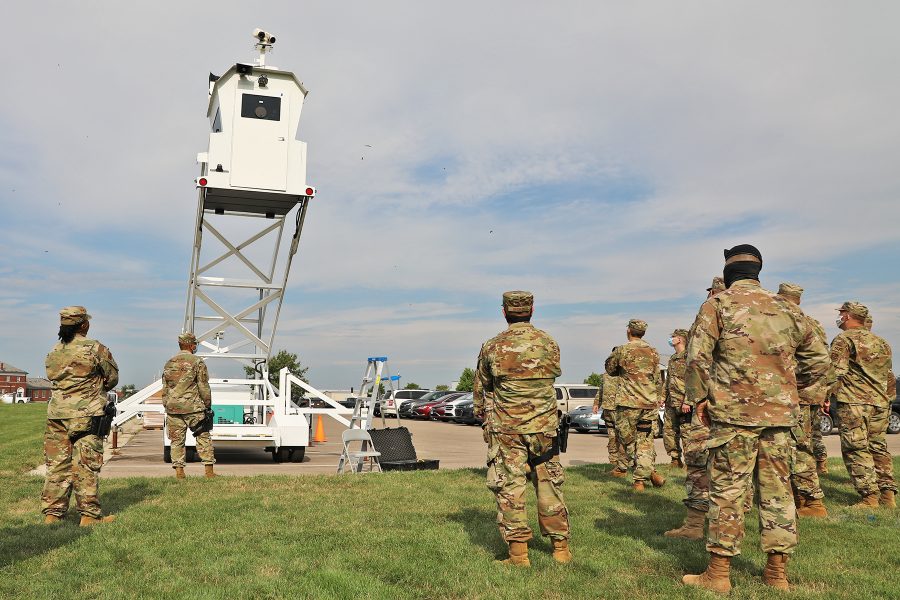Air National Guard wings have slashed the number of citizen Airmen who drill in person on the same weekend and scheduled multiple drills per month to maintain readiness while mitigating COVID-19 risk, Chief Master Sgt. Tony L. Whitehead, senior enlisted adviser to National Guard Bureau Chief Army Gen. Daniel R. Hokanson, said Sept. 14.
“When we used to have maybe, say 1,000 to 1,500 [Airmen] at one installation at one time, we’ve cut that in half and sometimes even more, to where we’re using the weekends throughout the month,” Whitehead said during a panel about leading through the coronavirus crisis that was held as part of the AFA’s virtual Air, Space & Cyber Conference.
This change allows ANG to accomplish necessary training while still implementing social distancing, he said.
“We don’t want readiness to take a hit because we can’t all be together,” he said.
ANG also is employing virtual communication methods wherever possible, Whitehead added.
At least three ANG wings have also employed virtual drilling since the start of the pandemic.
In May, the Puerto Rico Air National Guard’s 156th Wing designed a fully digital drill that made use of “telecommuting tools and online training capabilities,” according to a May 28 wing release. Different units drilled on different days throughout the month, it noted.
“To ensure Airmen were able to engage productively for their entire two-day drill period, a catalog of training was created,” the release stated. “The catalog offered the resources to complete required annual computer-based training, unit-specific training, physical fitness, and job-specific training opportunities.”
The wing also gave Airmen the chance to take Federal Emergency Management Agency courses and ensured they had support-agency access, the release noted.
The Virginia Air National Guard’s 192nd Wing also employed remote drilling earlier this year.
In April, the wing’s 192nd Security Forces Squadron used online platforms to conduct a drill that every single one of its Airmen took part in, according to a June 8 Virginia National Guard release. The wing’s 192nd Maintenance Group, on the other hand, incorporated so-called “Left Seat/Right Seat” sessions into their drilling, in which senior noncommissioned officers taught their subordinate NCOs about how to provide feedback to their Airmen, the release said. Those NCOs were then tasked with advising their Airmen as the SNCO instructors looked on virtually.
And the West Virginia Air National Guard’s 167th Operations Support Squadron—part of the WVANG’s 167th Airlift Wing—conducted its first-ever remote unit training assembly from May 2-3 via Microsoft Teams, according to a May 8 wing release.
During the remote drill, squadron Airmen completed their annual Total Force Ancillary Training, received instruction in preventing suicides and sexual assault, and received pandemic-related financial advice, the release stated.
“Holding the vUTA for the OSS was an integral way to get information to our members and keeping them up to date with what we are doing around the state in response to COVID-19,” 167th Operations Group First Sergeant Senior Master Sgt. Jacki Weddle said in the release. “Just interacting with our Airmen was so important to the leadership team.”
Air National Guard Director Gen. Michael A. Loh said ANG made this training flexibility possible by empowering wing leaders to make planning-related calls.
“We pushed that authority down to the lowest level for them to reschedule drills, and make it … easier to comply with all the restrictions that the [Centers for Disease Control and Prevention] has put out there for combating COVID, and making that happen,” Loh told reporters during a Sept. 14 vASC media roundtable.
Loh also praised ANG units for taking creative approaches to training, maintenance, and teaming to keep their Airmen safe amid the pandemic, and noted that “CARES Act funding and other resources” have helped ANG persevere on these fronts despite the coronavirus challenge.
